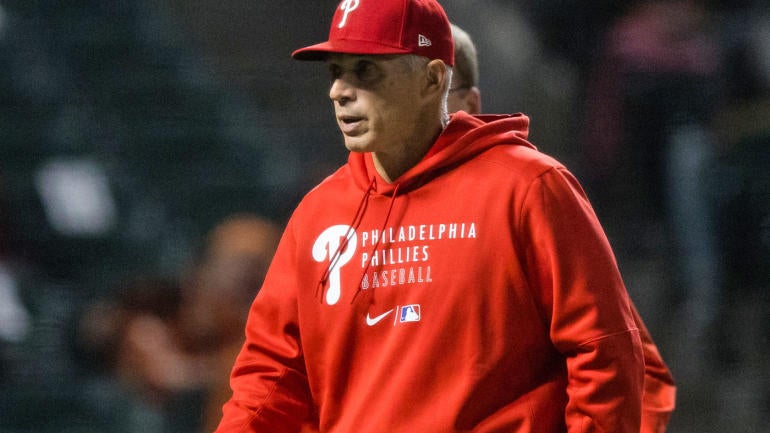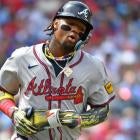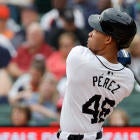
The first player to be tossed from a game as part of MLB's crackdown on the use of foreign substances by pitchers wasn't a big-name star on his way to an All-Star game or Cy Young race. It was Mariners middle reliever Hector Santiago, owner of a career 4.12 ERA and 8.1 K/9. Santiago was ejected from Sunday's game following his appearance and had his glove confiscated after the umpires found something during the routine check following the inning.
That's a pretty low-key way for the league's new focus to manifest itself, and outside of a few "the lady doth protest too much, methinks" displays from pitchers to their post-inning checks, it's been a pretty low-key change so far -- Joe Girardi's lame attempts to game the system notwithstanding. We haven't seen any star pitchers get busted. There haven't been any high-profile hit batters as a result of pitches losing grip of the ball, and the game doesn't look that different since the league began this crackdown.
Still, that's not to say there have been no changes. And, with some high-profile pitchers in particular -- notably, the two biggest free agent pitcher signings of the past two offseasons -- there does appear to have been some dips in effectiveness. And offense is up in the month of June, though whether that's a result of the crackdown or changes in the weather is worth trying to figure out, too.
So with that in mind, let's look into how the first week of the crackdown on foreign substances has gone, and whether there are any noteworthy trends we need to know. I looked at how it is impacting specific players and what it might mean for their value moving forward here.
- We talk Tarik Skubal, whether to add Zach Thompson or Kyle Muller, plus Keston Hiura and Phillies, Tigers and Reds bullpens on the Fantasy Baseball Today in 5 podcast. You can follow us to get the latest episodes on Apple, Spotify or wherever you get your podcasts.
Before you get into the changes we've seen on the individual pitcher level, we should probably look at what kind of changes we might have seen -- if any -- on the league level. Of course, because this has been such a strange season, it's worth breaking the season into several component parts to try to get the full picture. Because the offensive environment we saw in April wasn't the same one we saw in May or June, even before the foreign substance ban was enforced.
So here are some key stats and as they looked in April, May, June 3 through 21 -- when the league sent a memo saying a crackdown was coming until the crackdown actually started -- and then the last week with the crackdown in effect. What we'll be looking for are changes in strikeout and walk rates, fastball usage, contact rate, hit-by-pitch rate and hitter results. Here's what that looks like:

Fantasy Baseball Today Newsletter
Your Cheat Code To Fantasy Baseball
You're destined to gain an edge over your friends with advice from the award-winning FBT crew.
Thanks for signing up!
Keep an eye on your inbox.
Sorry!
There was an error processing your subscription.
| | April | May | Post-Memo | Post-crackdown |
PA | 28327 | 31072 | 17238 | 5655 |
BB% | 8.9% | 9.0% | 8.4% | 9.7% |
K% | 24.4% | 24.0% | 23.3% | 23.6% |
OBP | 0.309 | 0.315 | 0.318 | 0.318 |
SLG | 0.389 | 0.397 | 0.417 | 0.391 |
BABIP | 0.283 | 0.292 | 0.296 | 0.287 |
Fastball% | 50.7% | 50.9% | 51.4% | 50.7% |
Contact% | 75.0% | 75.5% | 76.3% | 75.6% |
HBP% | 1.3% | 1.1% | 1.1% | 1.1% |
The interesting thing here is how hard it is to find any obvious trends here. Offense is up across the board since the start of May, and that trend (mostly) continued in the post-crackdown world. But you'd be hard-pressed to identify the "pre-crackdown" and "post-crackdown" worlds just from the statistical record.
One thing that does stand out to me is that fastball usage hasn't really changed. One of the primary benefits of using foreign substances is to increase spin rate, something that is especially important on fastballs -- more spin means more apparent "rise" on the fastball, which typically leads to more swinging strikes with the pitch. Fastball usage has been in decline league-wide for a long time, but more pitchers have been able to use their fastballs to generate swings and misses -- per BaseballSavant.com's Statcast data, 34.7% of qualifying pitchers (225 pitchers) have a whiff rate of at least 25% on their four-seam fastballs, a number that was 31.1% in 2019.
My assumption was that, if fastballs were less capable of generating whiffs, pitchers would move away from them even more. In the arm's race between hitters and pitchers, whiffs remain the most valuable way to avoid homers, and I assumed pitchers would continue to chase those whiffs, even if it meant using the fastball less. At least so far, that hasn't been the case.
It's also noteworthy that hit-by-pitches aren't up (so far) -- 1.1% of all plate appearances ending in HBP is still very high based on historical standards, but at least (very) early on, the lack of grip-enhancing substances hasn't led to more HBP. That was one of the key arguments many would adopt for why pitchers should be allowed to use grip enhancers. Maybe not.
Walk rate is up pretty significantly, however, so maybe that argument isn't entirely without merit. Obviously, the small-sample caveat applies to everything since the crackdown, but that does look like a potentially meaningful change. And it's a change that could make it harder for pitchers to go deep into games, exacerbating another long-term trend.
For all the teeth-gnashing, at least so far, it doesn't seem like there is a significant change in pitcher performance, at least on a population level. That's interesting enough, but for Fantasy players, the population level isn't the only thing that matters -- if the performance of your average fourth-starter or middle reliever isn't changed, that doesn't really matter too much to us.
But, while there may be limited population-level effects, if some pitchers are disproportionately affected, that would be very noteworthy. But that's a story for another column.






















